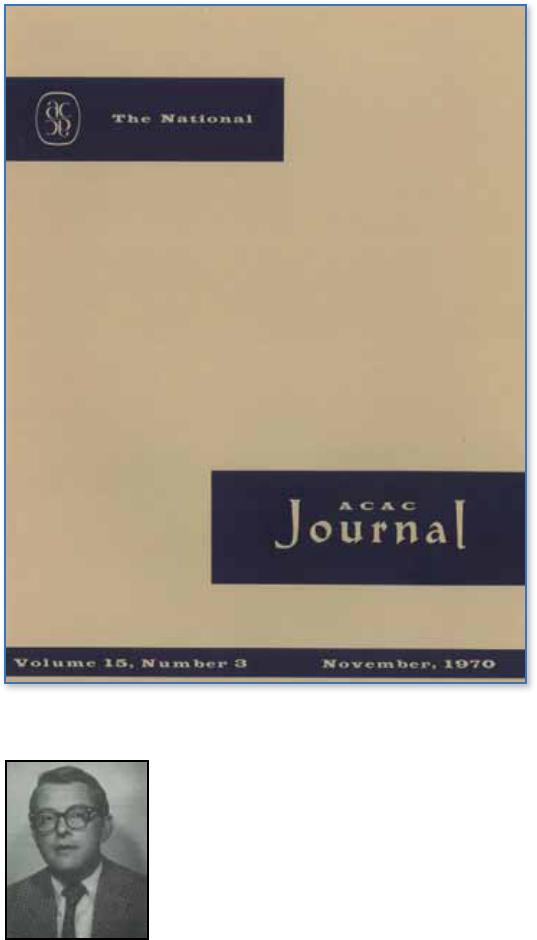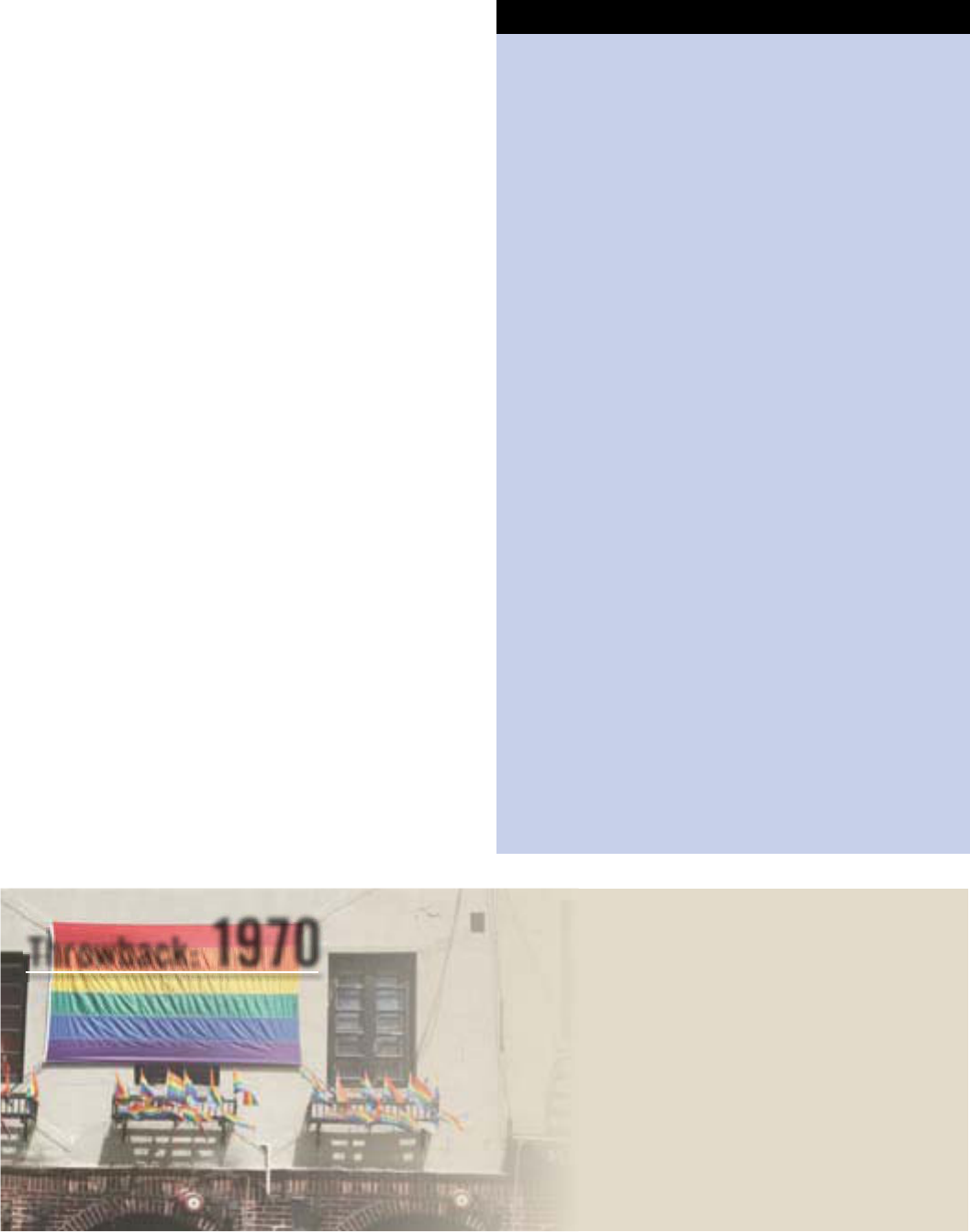
| WINTER 2012 JOURNAL OF COLLEGE ADMISSION
20
WWW.NACACNET.ORG
From 1970: The admission requirements of American colleges and universities have been the
subject of considerable speculation and investigation since Harvard College first set up its
requirements for admission in 1642. It is the intent of this paper to present an overview of the
historical development of college admission requirements through a chronological review of the
related literature.
ANDREW V. BEALE is a University of Virginia Ed. D. in Counselor Education and is now an
assistant professor at Virginia Commonwealth University.
The Evolution of College
Admission Requirements
The National ACAC Journal Volume 15, Number 3
November 1970
by Andrew V. Beale
By the middle of the nineteenth century,
there was no substantial agreement
among colleges as to what subjects
and how much should be required
for admission. Such diversity soon
came to be a source of perplexity and
annoyance to secondary schools as they
attempted to instruct their students in
the requirements for college entrance.
Out of the conflicts arising from the
diversity of entrance requirements
came the first efforts toward the
development of a national movement
for uniformity in college admissions.
Response: “The More Things Change, The More They Stay the Same” by Andrew V. Beale on page 23
WINTER 2012 JOURNAL OF COLLEGE ADMISSION |
21WWW.NACACNET.ORG
The Literature
One of the earliest studies done in the area of college admissions
was the work of Broome,“A Historical and Critical Discussion of
College Admission Requirements,” published in 1903.* Broome
described the development of college admissions during the
seventeenth and eighteenth centuries as the story of entrance
requirements and admission procedures at Harvard College. During
this period, prospective students at all major American colleges
and universities were examined as to their character, background,
and demonstrated proficiency in Latin and Greek. Later, toward
the end of the eighteenth century, a new requirement, a working
knowledge of arithmetic, was added to Latin and Greek as a
required subject for admission to college.
(*This study contributed, among other things, a history of admis-
sion requirements for the 150 years prior to 1800, during which
time there were no college cat alogs issued, the data being gath-
ered from old records, minutes, and statutes.)
The beginning of the nineteenth century marked the development
of private academies which served to meet the growing popular
demand for a less classical and more practical type of education.
Influenced by the academies, colleges began to emphasize a wider
range of subjects required for admission and a greater freedom
of option. As an example, at the University of Chicago during the
middle of the nineteenth century, it was necessary for a candidate
for admission to the freshman class to present at least thirteen
units in English, Latin, mathematics, ancient history, and a mod-
ern language as required subjects (Reeves & Russell, 1933).
By the middle of the nineteenth century, there was no substan-
tial agreement among colleges as to what subjects and how much
should be required for admission. Such diversity soon came to be
a source of perplexity and annoyance to secondary schools as they
attempted to instruct their students in the requirements for college
entrance. Out of the conflicts arising from the diversity of entrance
requirements came the first efforts to ward the development of a
national movement for uniformity in college admissions.
A committee of the National Education Association, the Committee
of College Entrance Requirements, presented a report in 1900
covering a four-year investigation of admission requirements and
ways and means of securing uniformity in college admissions. The
conclusions reached by the committee constituted the first step on
a national scale toward bringing the secondary schools and colleges
into cooperation. It was also during this period, 1890 to 1920, that
area accrediting agencies were organized to secure united action
toward uniform college entrance requirements (Kelly, 1940 ).
As patterns of entrance requirements developed, numerous
studies were carried out in terms of identifying requirements for
admission to college. Kingsley, in 1913, compiled the admission
practices of over three hundred institutions of higher education
located throughout the United States. This was one of the first
attempts to present the admissions practices of a large number
of institutions from all sections of the country. Earlier studies had
typically traced changes in admission policies and practices of a
few select institutions through a number of years. Kingsley found
that changes in entrance requirements were in the direction of
greater insistence upon the completion of a four-year high school
grade average, recommendations, and test scores.
During the ten-year period 1946 to 1956, college entrance
requirements reached a fairly uniform level. Investigations by
Nelson (1951), Traxler and Townsend (1953), Emanuel (1953),
and Knutson (1954) revealed that most colleges tended to admit
students on the basis of six major factors: 1) high-school graduation,
2) a minimum number of prescribed units in designated subjects,
3) rank in graduating class, 4) recommendation of the principal, 5)
personal interview, and 6) aptitude and achievement-test scores.
In 1956, Bowles proposed that colleges could give up the formal
entrance requirements of yesteryear because of the availability of
tests which enabled colleges to make selections on the basis of
aptitude and promise that were as good as, and perhaps better
than, selections made on the basis of the colleges’ old standard-
ized requirements. Five years later, Berger (1961) reported that
more than 75 percent of the admissions directors included in his
survey considered Scholastic Aptitude Test scores as “absolutely
essential” to the admissions process in 1960. Thus, testing by
standardized examinations sponsored by regional or national as-
sociations had become an accepted part of the college admission
process during the late 1950’s (Fishman and Pasanella, 1960).
The most salient and important trend in college admissions
during the 1960’s was the growing concern for the inclusion
of environmental and non-intellective variables in the selection
process (Hight, 1962; Heist & Webster, 1965; Yonge, 1965;
Educa tional Records Bureau, 1964; Morris, 1965). Colleges during
the 1960’s tended to give more attention and weight to personal
data in admitting students than they did during the 1950’s.
Admissions directors particularly desired information on character,

| WINTER 2012 JOURNAL OF COLLEGE ADMISSION
22
WWW.NACACNET.ORG
emotional stability, and leadership qualities. While comparatively
fixed patterns of secondary-school requirements for entrance
existed, the typical college allowed individual variations from these
requirements if the candidate was otherwise qualified. This shift
in emphasis from the prospective student’s academic abilities to
his personal attributes was heralded by many as a major break
through in the area of college admissions during the 1960’s.
Summary
The development of college admissions requirements during the
seventeenth and eighteenth centuries was basically the story of the
admission policies and practices at Harvard College. Candidates
for admission were examined on their ability to read and translate
Latin and Greek, and a careful check was made of their character
and background. With the exception of changes in the content of
the subjects required for entrance, requirements for admission to
American colleges and universities changed little during the 1800’s.
Studies conducted during the 1900’s revealed that changes in
admission requirements were in the direction of greater insistence
upon the completion of a four-year high school course and greater
flexibility in ad mission standards. The trend during the 1930’s
and 1940’s was for colleges to accept secondary school graduates
on the basis of ability rather than subjects studied. The decade
1949-1959 witnessed an increased interest in standardized
examinations sponsored by regional or national associations.
The most apparent development in college admissions during the
decade of the 60’s was the growing emphasis placed upon envi-
ronmental and non intellective factors in the admission process.
Many colleges became increasingly aware of the need to broaden
their view of the admission process in order to ensure that the full
range of talent that an institution is capable of developing is prop-
erly rep resented in the student body.
Berger, A.B. “How the college admissions
officer views counselor recommendations.”
Vocational Guidance Quarterly, 1961, 9, 256.
Bowles, F.H. “The evolution of admission
require ments.” The interaction of school and
college. New York: College Entrance Examina-
tion Board, 1956.
Brammell, R.P. Articulation of High School and
College. Washington: Government Printing
Office, 1933.
Broome, E.C. A historical and critical discussion
of college admission requirements. New York:
College Entrance Examination Board, 1963,
Reprint.
Educational Research Bureau, Admission to
American Colleges: Summary of policies and
practices. New York: Educational Records
Bureau, 1964.
Emanuel, V.H. “College-entrance requirements
ten years after the eight-year study.” The
School Re view, 1953, 61, 521-526.
Ferguson, H.A. “Trends in college admission
re quirements.” School and Society, 1938, 48,
407-411.
Fine, B. Admission to American Colleges: A
study of current policy and practice. New York:
Harper and Brothers, 1946.
Fishman, J.A. and Pasonella, A. K. “College
admission-selection studies.” Review of Edu-
cational Re search, 1960, 30, 298.
Grossman, D.A. “Trends in admissions to
higher institutions.” Bulletin of the American
Association of Collegiate Registrars and Admis-
sions Officers, 1935, 10, 253-261.
Heist, P. and Webster, H. “Selection, predic-
tion, and persistence.” Review of Educational
Research, 1965, 3S, 254.
Hight, W.B. Patterns of admission require-
ments to selected American colleges and
universities. Unpub lished doctoral disserta-
tion, University of North Carolina, 1962.
Hunsinger, M. The selection of persons to be
trained as teachers of commercial subjects.”
Encyclopedia of Modern Education. New York:
Philosophical Library, 1943, 154-155.
Kelly, F.J. Collegiate accreditation by agencies
within states. Washington Government
Printing Office, 1940.
Kingsley, C.D. College entrance requirements.
Wash ington: Government Printing Office, 1913.
Knutson, H. Admission requirements: A study of
admission requirements. Unpublished doctoral
dis sertation, University of Wyoming, 1954
Kurani, H.A. Selecting the college student in
Amer ica. New York: The Rumford Press, 1931.
Linton, C. A study of some Problems arising in
the admission of students as candidates for
professional degrees in education. New York:
Columbia Uni versity, 1927.
McKown, H.C. The trend of college entrance
re quirements 1913-1922. Washington:
Government Printing Office, 1925.
Maddox, M.E. Problems of college admission.
Lexing ton: University of Kentucky, 1947.
Morris, L.F. An examination of pre-
admission selection with reference to methods,
theories, and trends as related to four-year
degree-granting institutions of higher educa-
tion in the United States. Unpub lished doctoral
dissertation. University of Colorado, 1965.
Nelson, L.W. “Are we in need of a new plan for
evaluating student qualifications for college
en trance?” The Bulletin of the National As-
sociation of Secondary School Principals, 1951,
30, 87-92.
Reeves, F.W. and Russell, J. D. Admission and
retention of university students. Chicago: The
Uni versity of Chicago Press, 1933.
Traxler, A.E. and Townsend, A. Improving
transi tion from school to college. New York:
Harper & Brothers, 1953.
Yonge, G. D. “Students.” Review of Educational
Research, 1965, 35, 261.
REFERENCES
Throwback: 1970
26th NACAC National Conference is held
in Boston, MA. Margaret E. Perry (University of
Chicago, IL) is NACAC president.
The Ohio National Guard opens fire on Kent State
students, killing four students and wounding nine.
The first Gay Liberation Day March
is held in New York City.
